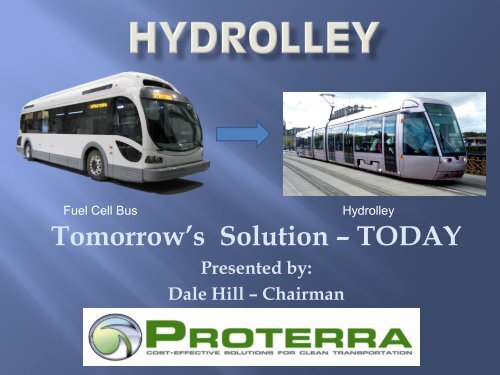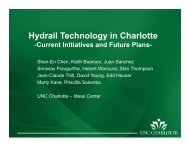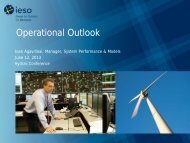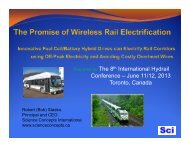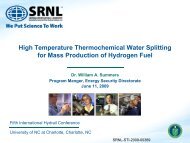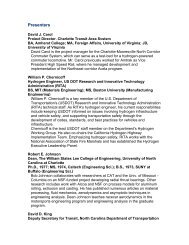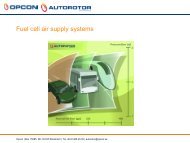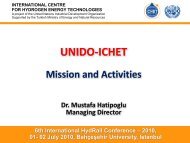Dale Hill
Dale Hill
Dale Hill
- No tags were found...
Create successful ePaper yourself
Turn your PDF publications into a flip-book with our unique Google optimized e-Paper software.
Fuel Cell BusHydrolleyTomorrow’s Solution – TODAYPresented by:<strong>Dale</strong> <strong>Hill</strong> – Chairman
• Purpose built designs that achievemaximum performance improvements• Best fuel economy• Low maintenance• Built to last• Functional designs• 20-40% weight reduction• 40%+ longer life• Less costly to maintain thanconventional metal bodies• Improved safety with crashresistant compositestructureTotal VehicleSolutionsCompositeTechnologiesTerraVolt TM EnergyStorage SystemsBus and TruckProDrive TMSystems• Can be fully charged inless than 10 minutes• Ultra safe system design• Outlasts the vehicle• Scales to suit vehicle typeand duty cycle needs• Enables all-electric commercial vehicles infixed-route applications today• Uses existing power sources• Makes it possible to reduce the amount ofon-board energy storage and associatedcostsTerraCharge TMRapid ChargingSystems• 200-400% improvement in fuel economy• Starts as an all-electric system to maximize fuelsavings• Add any small APU to extend vehicle range• Up to 92% regenerative braking recapture• Uses all electric components5
Jeff GranatoCEO & President<strong>Dale</strong> <strong>Hill</strong>Founder, CTO,ChairmanTo Be AnnouncedVP OperationsBen van derLindenDirector - ProductPrototypingStephenMisencikDirector –Composites Tech.JoshuaGoldmanDirector - BusinessDevelopmentFounderTransTeqPrior PositionSr. Manager at McKinsey & Co.,Global Growth Strategy Practice.Director ofManufacturingTextronDirector of R&DNABI BusVP Product Dev.Martin MariettaCompositesDirectorHybrid SystemsISEEco Mark IVTextronNABI CompoBusMMC CompositesISE Hybrid Sys.StrengthsSeasoned CEO & CFO, managing, organizing andleading business growth for over 20 years.Developed the most successful fleet of CNG hybridbuses in the world, which carried 150 million passengersto date.20 years experience in operations, advancedmanufacturing, engineering and Lean Sigma. Deepexperience in vehicle and vehicle system manufacturingand product development.Considerable global bus industry, R&D, manufacturingexperience, and launched the world’s first compositebody bus.Technology transfer of high strength marine compositesto the bus industry, and has over 25 years experience incomposite engineering design and manufacturing setup.Led the development of hybrid drive systems for ISE, cochairsseveral standards boards and is widely consideredan industry expert in hybrid drive systems.To Be AnnouncedDirector -MarketingLead EngineerChevy Volt, GMChevy VoltLead engineer on game changing electric powertrain forthe Chevy Volt electric vehicle; directed the dailyactivities of all electric drive unit product developmentteams.
ConceptModelIn just 20 monthsAlpha Unit
STATUS(1) Achieve a fuel cell bus vehicle cost of no greater than 5times that of a commercial transit bus(2) Achieve a 4–6 year or 20,000–30,000 hours of durabilityfor the fuel cell propulsion system.(3) Achieve a doubling of the fuel efficiency compared to acommercial transit bus to enhance energy security.(4) Achieve fuel cell bus performance equal to, or betterthan, equivalent commercial transit bus (acceleration,grade-ability, range, braking distance, etc.).(5) Exceed the 2010 heavy-duty bus emissions standards.(6) Foster economic competitiveness in fuel cell bustechnologies.(7) Increase public acceptance for fuel cell bus technologiesAchieved Bus 25-7000 hr -Up from 4000Testing validates10 + mpgYesYes – ZEVYesYes
• Develop a fuel cell bus that, once economies ofscale are reached, can be sold in the range of $1 M• Design a Technology Specific Bus with compositebody to reduce weight, provide better weightdistribution and lower CG• Design a bus that is “White Book “ compliant• Design a bus that is battery dominant to reducefuel cell size to that of an automotive size fuel cell• Develop a new energy storage system employingthe latest battery technologies and batterymanagement and system control and integration• Engineer a fuel cell arrangement that willmaximize stack lifeSTATUSYesYes
• Develop a drive system that will double fueleconomy over a conventional diesel bus• Develop a shorter bus that will carry as manypassengers as a 40’ bus• Develop an integrated, redundant control system• Develop a vehicle that operates on 100%Domestic Energy• Develop a bus that will be a battery dominanthybrid electric vehicle that can accept a variety ofAuxiliary Power Units, including fuel cells inorder to maximize FTA design dollarsSTATUSYes –10 mpg34’ 9”37 seated pass.YesYesH² % Elec.Yes
TWO HYDROGENICS 16 kW PEM Fuel Cells•Parallel Connected•Alternate operation adaptable•Constant output for extended life
• 400 + hours fuel cell testingcompleted to dateThe testsmet andexceededProterra’sexpectations• Vehicle initializationcompleted in two days vs.two weeks planned• Control system allows twofuel cells on the samenetwork• 20 second startup• Total power output:18.6kW• Heat load: 15.7kW6/5/2009 16
Core System ComponentsBattery Management SystemTerraVolt Energy StorageModule Pack StringsVehicleUndersideBatteryStringsCustomer Benefits• Industry’s only system that canbe fully charged in less than 10minutes• Ultra safe system design‣ Puncture and heat resistant‣ Sophisticated batterymanagement system operatesat the ‘cell’ level• Energy storage system outlaststhe vehicle or longer• Scales in size and energycapacity based on vehicle typeand duty cycle needs17
80% Efficient Drive TrainWithout APU• Battery System = 98.5% Avg.• Traction Motor = 92.5% Peak; 85% Avg.45% Efficient APU• DC-DC Converters = 94% Peak; 90% Avg.• Fuel Cells = 55% Peak; 50% Avg.85% Efficient Hotel Loads• HVAC: 85% Efficient -11.8kW Peak; 9kW Avg.• Power Steering: 80% Efficient - 5kW Peak; 1kWAvg.• DC-DC Converters: 90% Efficient; 1kW Avg.Waste>55%Efficiency at32kW/ hr6/5/2009 18
• Build upon cell and modulelevel testing and full vehiclesystem testing to addconfidence to our lifetimeand durability of the ESS asapplied to the Foothillproposed drive cycle• Have partnerships withNREL and FTA (Penn StateUniversity) as well as UC-Davis for various portions ofthe complete ESS testing• Once complete we can thenaddress long term warrantyof the complete ESS
BusWeight 27,000 lbPassengers 67HP150 kWRolling Resist. .01Energy Usage@ 60 mph 2 kWh/mileFuel CellRequirement 32 kWLight Rail110,000 lb220450 kW.0027.5 kWh / mile120 kW
= $ 4MM/MILE= Unsightly= Ability to extendsystem= Ability to storenight time energy


